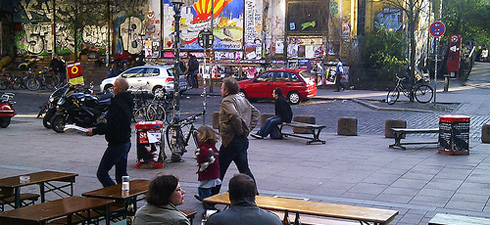For decades now, the subculture has been moving into unsightly, dilapidated sections of many big cities, breathing new life into neighbourhoods. Artists and other creative professionals often form the vanguard of urban renewal. Ever on the lookout for cheap housing, studios and offices, they seize on rentals in areas that others are eager to flee as soon as they can.
For a long time it looked as though a close nexus had been forged between the sociocritical left-wing zeitgeist and the flowering of contemporary art. In cities like Frankfurt, Hamburg or Berlin, artists and otherwise creatively-involved occupants would defend their turf – often with plenty of wit and conviction – against frustrated town planners and unscrupulous developers. Many a neighbourhood in those cities has now become quite livable – thanks mostly to them. Since German reunification, however, the traditional politico-ideologically motivated squatter has, in many cases, been supplanted by artists and creative professionals of a personally ambitious caste.
Then the same metamorphosis almost invariably ensues – in Berlin, Hamburg or Cologne as in Amsterdam, Copenhagen, Barcelona, London, Warsaw or Prague: once artists and creators rent digs in a given neighbourhood, trendy cafés and restaurants follow in their wake. Before you know it, young men with five-day beards and young post-neo-something-or-other girlies in cool second-hand vintage clothes fiddle about on their laptops, planning new "projects". The neighbourhood they have occupied is suddenly deemed “interesting”, small unconventional shops sprout up, then galleries and architects’ offices bring up the rear. Presently, the rents start rising.
The fact that a group of radical left-wing autonomists recently savaged an art gallery in Berlin goes to show how far the battle lines have shifted in the meantime. Nowadays many artists and creative folks are no longer deemed avant-garde rebels, but harbingers of gentrification and representatives of a new property-owning bourgeoisie. The conflict points up not only the vision of art espoused by the vandals, who apparently can only stand artists when they serve their ideological purposes; it also shows how much the relationship between art and political orientation has changed. The cool artists with designer glasses and hip outfits have long since forsaken their bourgeois-bashing stance and now seek to join the establishment. They were brought up in an age in which creative enterprise morphed into one of the fastest-growing industries around and art into a service industry for upscale investment.
Nowhere is the fusion of creative impetus and big business more conspicuous than here. The image of the artist as an unsociable misfit, a recluse on the fringes of society, is long since outmoded: successful artists are often as not the life of the party, smack in the middle of the action; like entrepreneurs, they engage in calculated networking, romp through art fairs the world over and fly as frequently as others take the bus.
In this metier, as in any other, only the usual happy few make it big. But their careers serve as a role model for a whole generation of epigones, who no longer conceive of art as the special case of a precarious professional trajectory, but as the fast lane to get way out in front of the pack.
So it is fitting that artists and creators should now be solicited by urban planners and investors. And that bears out US sociologist Richard Florida’s famous theory about the close connection between culture and economic growth, in which the cultural environment is the most decisive locational factor.
Such a monolithic image of the artist-enterpreneur is actually a cliché, however, that has little to do with the reality of most creative professionals. In cities like Hamburg, Cologne or Berlin, for instance, which take particular pride in their creative sector, most of the artists rank with the lower class in terms of average annual income. Often as not, they are among the first to find themselves unable to afford the rent hikes in what have become “in” neighbourhoods – even if they themselves helped trigger that development.
And so it is that, as harbingers of gentrification, artists and creators are among the losers of this rapid transformation, despite the widespread public perception of them as winners. This warped perception shows above all how the liberal Zeitgeist has succeeded in generating a hype that even radical autonomists are now prepared to buy.
Was this article useful? If so we are delighted!
It is freely available because we believe that the right to free and independent information is essential for democracy. But this right is not guaranteed forever, and independence comes at a cost. We need your support in order to continue publishing independent, multilingual news for all Europeans.
Discover our subscription offers and their exclusive benefits and become a member of our community now!












